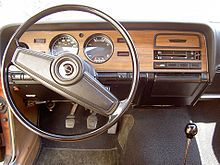Mercury Capri
From 1979 to 1986, the second generation Capri became part of the Mercury model line as a U.S. built pony car, a badge engineered variant of the contemporary Ford Mustang.
In line with the Mustang, the Capri was styled with a long hood and a short deck (trunk lid; later hatchback) with a fastback-style roofline.
As an option, for 1972, Mercury introduced a 2.6L Cologne V6, becoming the first American-market vehicle marketed by Ford Motor Company with a V6 engine.
The previous chrome bumper was reinforced with a steel tube and attached to the frame with shock absorbers (extending the length of the body several inches).
As part of an interior revision, the Capri was given a new steering wheel, dashboard, and seat trim along with a redesigned wiring harness.
A Mercury version of the Ford Mustang II badged as a Capri (as evidenced by a proposal using the Mustang II's 2+2 body with a rounded rear quarter window style and characteristic bodyside sculpting) was briefly considered, but the strong sales of the Ford Capri (Mk1) as a captive import shelved those plans.
At its peak, yearly Capri sales in North America were the highest for any import vehicle (except for the Volkswagen Beetle).
It's solid as a Mercedes, still compact and light in the context of 1974 barrier busters, fast, reasonably economical of fuel, precise-handling, and quick-stopping: its engine and drivetrain are both sporty and refined.
It goes, stops, and handles, it's well built and it has that sturdy, precise European character that makes it something special for Americans and Canadians.
"[9] The car features prominently in the 1982 movie "The First Time," with Jennifer Jason-Leigh, where her grandmother gives her hers after she buys a new Corvette and teaches her to drive a stick.
In the US, anti-tobacco advertising laws required a name change to Capri II S. The interior received special seats and door panels: black with gold cloth inserts.
The Capri was styled with its own front fascia, a vertically mounted grille, and dark-tinted tail light with horizontally ribbed lenses.
Along with that revision came newly styled tail lights, rear bumper cover and front end grille.
1983 Crimson Cat - Bright red (code 27) paint with gold striping and Cougar XR-7 TRX wheels set this car apart.
1984 Charcoal Turbo RS - A Capri RS Turbo that was only available in charcoal upper-silver lower exterior paint with light grey striped rub moldings, Garrett 60 trim turbocharger, enhanced multi-port EFI four-cylinder engine, Michelin TRX package, 5.0 HO Sway bars, 3.45:1 limited-slip rear axle, hood scoop, and orange and red lettering and striping.
1985 Mercury Motorsport Capri- Built as pace car replicas to commemorate the 1985 Detroit Grand Prix & MotorCity 100.
These were also cosmetically modified by American Sunroof Company for Mercury and are highly sought after for their low production of less than 50 cars and availability in only Michigan & Ohio.
The Coupes were tuned and enhanced with several suspension and visual upgrades including striping, a built-in radar detector, ground effects, Hella fog lights, headlight and taillight covers and Italian Campagnolo honeycomb-style wheels.
The manual top design is specific to the vehicle, requiring design-specific equipment (such as seals, weatherstripping, and windshield moldings).
Fabrication required a replacement rear deck lid, floor reinforcements, quarter panel caps, tonneau cover and a windshield that was raked back an extra 10 degrees In total, 557 convertibles were built during its 1984–1986 production run.
The 225/50/15 low profile size of these tires (as opposed to the standard 5.0L Capri's 225/60/15) raised the ASC/McLaren Coupe's effective gear ratio from 3.08:1 to approximately 3.35:1.
Along with folding back seats (allowing access to the trunk), the Capri also offered the option of a removable hardtop (similar to the MX-5).





